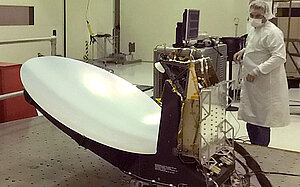AMR: Advanced Microwave Radiometer

The AMR is a heritage of the Jason-3 Advanced Microwave Radiometer (AMR). Like the AMR, it acquires measurements via three separate frequency channels to determine the path delay of the altimeter's radar signal due to atmospheric water vapor and liquid water in the atmosphere.
Function
The AMR measures water vapor content in the atmosphere so that we can determine how it impacts radar signal propagation. Its measurements also can be used directly for studying other atmospheric phenomena, particularly rain.
Changes with respect to Jason-3
The instrument is an heritage reflector design with two AMRs feed horns to meet baseline requirements. Thermal design and mechanical layout of electronics now accommodates operating two chains simultaneously. In the case of one failed AMR chain, the cross track implementation provides increased resiliency to meeting the threshold requirements.
Principle
The AMR is a passive receiver that collects radiation reflected by the oceans at frequencies of 18.7, 23.8 and 34.0GHz.
Radiation measured by the radiometer depends on surface winds, ocean temperature, salinity, foam, absorption by water vapor and clouds, and various other factors. To determine atmospheric water vapor content accurately, we need to take into account sea surface and cloud contributions in the signal received by the radiometer. That is why the AMR uses different frequencies, each of which is more sensitive than the others to one of these contributions. The main 23.8-GHz frequency is used to measure water vapor; the 34-GHz channel provides the correction for non-rainbearing clouds; and the 18.7-GHz channel is highly sensitive to wind-driven variations in the sea surface. By combining measurements acquired at each of these frequencies, we can extract the water vapor and liquid water signals.
Two independent instrument chains measure wet path delay at the center of each KaRIn swath.




